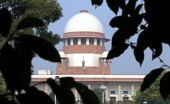How India missed getting its first woman Chief Justice India
Written by Alok // November 26, 2010 // Law & The Judiciary // 13 Comments
Four women have been elevated to the post of the Judge of the Supreme Court of India in 60 years of the Court’s existence. This is the story of how one of them missed becoming the Chief Justice of India.
A little background first.
Appointment of the Chief Justice of India, unlike the appointment of judges to the Supreme Court of India, is a very transparent process. The senior-most judge on the Bench is, by convention, appointed the Chief Justice of India. Senior-most here means the judge who has been judge at the Supreme Court for the longest. To take the most recent example, when Justice KG Balakrishnan retired in 2010, among the sitting judges of the Supreme Court of India, Justice SH Kapadia had served the longest on the Bench, i.e., about six and a half years from his appointment on 18.12.2003.
This convention itself dates back to the days of the Federal Court of India set up under the Government of India Act, 1935 and is one of those that continues because no one has found a better way. Or rather, the attempts to change the convention have been so controversial that no Government or Chief Justice of India has tried to by pass the same for reasons I’ll explain.
There have been three attempts to bypass the convention or “supersede” judges, where the ruling authority has sought to overlook the senior most judge of the Supreme Court in favour of someone else in appointing the Chief Justice of India. All three attempts have been hugely controversial for different reasons.
The first “supersession” was in 1943 when Justice Patrick Spens was appointed Chief Justice of India in preference to the senior-most judge on the Bench, Justice Srinivasa Varadachariar (then Acting Chief Justice). (It was alleged, and probably not without basis that one of the grounds of supersession was racial, as British judges and lawyers did not want an Indian as the Chief Justice of India. Justice Iyengar promptly retired adding fuel to the fire, that was only perhaps quenched when Justice Harilal J Kania was finally appointed Chief Justice of India, first on the Federal Court and then in the Supreme Court of India).
The second “supersession” involved three judges, the landmark judgement of the Supreme Court of India in Kesavananda Bharati v State of Kerala and the then Prime Minister of India, Mrs. Indira Gandhi. Justice AN Ray was appointed CJI by the then Government overlooking the three seniormost judges of the Supreme Court, including Justice Sikri’s recommendation for the post, Justice JM Shelat. Justice Shelat, and the other two judges, Justices AN Grover and KS Hegde retired in protest.
The motivation of Mrs. Gandhi for this supersession wasn’t hard to find. In the midst of her war with the judiciary, when the Court had struck down key legislation for being unconstitutional, Mrs. Gandhi wanted to assert her supremacy (yes, her supremacy and not the Parliament’s supremacy) over the judiciary and Justice Ray was the one judge who had consistently found the Government’s arguments favourable in such landmark cases. As the former Attorney General of India, CK Daphtary caustically remarked, “The boy who wrote the best essay won the first prize.”
The third, and possibly most infamous supersession, happened during the height of the Emergency, when Mrs. Gandhi was less than appreciative of Justice HR Khanna’s brave dissent in the ADM Jabalpur case. Needless to say, Justice Khanna resigned upon finding that he had overlooked in favour of Justice MH Beg to be appointed the CJI.
It is in these circumstances that a majority of the Bar, Bench and the Government have favoured continuing the convention to avoid unpleasant memories of the above controversies. Whether or not the convention should continue is a different matter altogether, but this is the circumstance in which we find ourselves, and this is what must be remembered in this story (which, if you, the ADD-led youth of India haven’t already forgotten, is about the woman who almost became CJI).
With this convention in place, it is possible to predict, with total accuracy whether or not a given judge of the Supreme Court will become the CJI. All one needs to do is see if on the date of the retirement of the CJI, how many years the given judge has spent. E.g., when the present CJI retires, Justice Altamas Kabir will be the senior-most judge, and when he retires, Justice PS Sathasivam, and after him, Justice RM Lodha, Justice HL Dattu and Justice TS Thakur, in that order. (If rumour and gossip are to be believed, and the noted Supreme Court Senior Advocate, Mr. Rohinton Nariman is appointed judge of the Supreme Court this year, then he will be CJI after Justice Thakur)
In 2000, in the Golden Jubilee year of the Supreme Court of India, three judges were to be appointed to the Supreme Court of India, sworn in by the then CJI, Justice AS Anand. They were, Justice YK Sabharwal, Justice Doraiswamy Raju and Justice Ruma Pal. The date of the swearing in was fixed on 29th of January and observers were quick to note, that barring any unfortunate catastrophe, Justices Ruma Pal and Sabharwal would have the same level of seniority in 2005 when Justice RC Lahoti retires as CJI. In such a case, convention demanded that the judge whose name was higher in the alphabetical order would be considered more senior and in such a case, Justice Ruma Pal would be CJI.
Justice Ruma Pal was (and is still) considered to be one of the finest judges in India and a great choice for elevation to the Supreme Court of India. Almost all lawyers who argued before her came away impressed by her clarity of thought and the speed with which she would grasp the issues at stake. Stern in the courtroom and incisive in her judgements, she commanded, not demanded, the respect of most of the advocates. One could do worse in appreciating her qualities than reading two of her best judgements in the Supreme Court; Pradeep Kumar Biswas v Indian Institute of Chemical Biology and BSNL v Union of India. The first woman Chief Justice of India would have been a great judge in her own right and not just a good woman judge.
Except that didn’t happen of course.
The day of swearing in was advanced by one day in the last minute to ensure that it coincided with the Golden Jubilee day of the Supreme Court of India, and somehow, Justice Ruma Pal did not get the message in time. Whereas Justices Raju and Justice Sabharwal were able to make it to Delhi in time for the swearing in ceremony in the morning, Justice Ruma Pal, based in Kolkata, was only able to make it to Delhi later, and sworn in on the afternoon. As a result, though sworn in on the same day, the fact that Justice Sabharwal was sworn in a few hours before her, meant that she wasn’t the seniormost judge and missed being Chief Justice of India by the narrowest of margins.
It is not exactly clear why Justice Ruma Pal did not receive the communication in time and though some attribute less than honest motives to the then CJI, there’s little to substantiate such rumours. While it wouldn’t have prevented Justice YK Sabharwal from being appointed CJI, it would have reduced his term by about half the length he actually served as CJI.
Since Justice Ruma Pal retired, no woman was elevated to the Supreme Court till Justice Gyan Sudha Misra was appointed in April 2010; a four year gap that does not reflect well on the Supreme Court Collegium. From the appointments so far, no woman is likely to be CJI before 2017 at least (and if rumours of Mr. Nariman’s elevation are correct, at least till 2022).
I don’t know if Justice Ruma Pal feels she “lost” something, but I’m sure that the Supreme Court as an institution did lose out by not having Justice Ruma Pal as the Chief Justice of India.
[Clarification: After I put out this post, it was pointed out to me by some that the delay in swearing in Justice Ruma Pal may not have been the only factor in breaking the "tie" of seniority between Justice Ruma Pal and Justice Sabharwal since Justice Sabharwal served on the Delhi High Court longer than Justice Ruma Pal served on the Calcutta High Court. I don't dispute this possibility but since seniority is counted from the time one has been sworn in, there was no need to "break the tie" at all.]
[ Edited also to correct a previous sentence which said "forenoon" instead of "afternoon". ] ]




13 Comments on "How India missed getting its first woman Chief Justice India"
The fact that if there are two judges appointed on the same day, seniority is determined on the basis of order of swearing in which itself is contingent on alphabetical order of names (and as you point out the selective delivery of messages), is just silly. Shouldn’t it simply be that the person more senior in age should become senior? That way, both persons, (if the occasion arises) can become CJIs and there is a rational ground for providing seniority. Which alphabetical order isn’t since after all, Supreme Court seniority is not an attendance register in school.
You’re right, but the “precedent” in this regard was apparently set when Justice AS Ahmadi was appointed CJI instead of Justice Kuldip Singh though both were sworn in on the same day.
I’d agree with your proposal but there is also an argument to be made that CJIs should have reasonably long tenures to allow them to properly carry out the administrative side of their functions. Administrative and judicial reforms needed to make the Supreme Court function properly and efficiently need investments of time and effort on the part of the CJI over a period of time. Very short tenures (i.e., less than a year) mean that the CJIs are either not inclined to undertake major overhauls or when they do undertake them, their successors may not share their focus and goals. This applies to the High Courts as well.
Yes I agree completely about longer tenures. But the solution is to have an honest discussion about retirement ages of SC and HC judges beyond the magic number of 65 or something of this nature. Not alphabetically appointing CJs which is arbit and stopgap.
Nice piece of work, Alok.. Bring on more of the ‘wide-eyed supreme court fact-ion’, too!
There was also Jaffer Imam, J. in the sixties who was superseded by Justice Ganjendragadkar. Of course the Hon’ble Imam, J. was widely believed to be suffering from some sort of ‘mental infirmity’ (as Ganjendragadkar J. put it in his autobiography) that led to his dozing off on the bench, blanking out during court proceedings and not handing in his judgments on time.
Justice Jaffer Imam was a great judge! He aws wrongfully bypassed because Gajendragadkar was pro-govt. always.
I agree to Arghya. Seniority of a judge has been very precisely discribed. It isn’t subjected to such a Faux Pas.
Paragraph writing is also a fun, if you be familiar with then you can write
or else it is complex to write.
I’m very pleased to discover this great site. I wanted to thank you for your time for this fantastic read!!
I definitely really liked every little bit of it and i also have you bookmarked to look at new stuff on your blog.
Hey there! This is my first visit to your blog! We are a group of volunteers and starting a new initiative in a community in the same niche. Your blog provided us valuable information to work on. You have done a outstanding job!
Trackbacks for this post